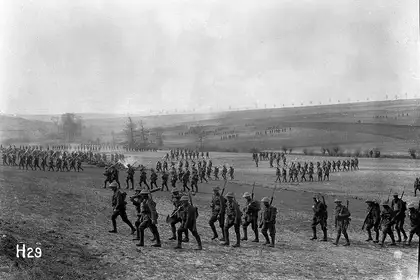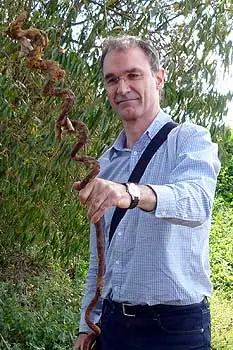
A scene from the Battle of Messines, 1917 (photo credit/Henry Armytage Sanders - Alexander Turnbull Library).
The discovery of an Anzac soldier’s boots and foot bones six years ago at the WWI Battle of Messines site in Belgium inspired a Massey University academic to learn more about a slice of military history he says has been overlooked in modern times.
Dr Jeff McNeill, a senior lecturer geography in the School of People, Environment and Planning moonlights as a history researcher, and is a leading New Zealand expert on the battle that resulted in 3700 New Zealand casualties including 700 dead in the final year of the Great War of 1914-1917.
An estimated 24,000 soldiers on each side were killed, wounded or went missing at the June 7-14 battle, known for the devastating impact of massive mines used by Allied forces that caused huge craters and literally blew soldiers into thin air.
In an essay titled The Foot, which he wrote for the Journal of Urgent Writing (Massey University Press) last year, he describes finding the soldier’s remains, along with an unopened phial of liquid iodine and a badge during a visit to the battle site. The boots and bones were later identified as those of a Kiwi soldier.
Dr McNeill has visited the site four times now and his upcoming book, Lost Victory: 2nd Anzacs of Messines 1917, tells a story that has drifted from the collective consciousness over the years. It is a story that deserves to be re-told and remembered for several reasons, he says.
“It was a decisive victory for the British and New Zealand Division – in fact the only one that year! It is famous for the 19 mines that blew a lot of Germans up – though not as many as others have claimed,” he says.
And while it has been lost in recent public memory, this notable victory for the Allies – due largely to the role New Zealand troops played there – was highly regarded as a success in claiming and holding a strategic ridge. This success stands in stark contrast to what unfolded a few months later at nearby Ypres (better known as Passchendaele).

Dr Jeff McNeill holding the base of German barbed wire stake found at Messines, designed to be screwed quietly into the ground to avoid noisy hammering that could attract a machine gun attack.
A different war story
Soldiers of the New Zealand Division were extremely well prepared, Dr McNeill says. “They had state of the art technology, new tactics, were highly trained and had for the main part excellent commanders. It largely puts to rest the popular ‘lions led by donkeys’ narrative [a phrase used to describe the British infantry of the First World War and to blame the generals who led them].”
The story of the New Zealand and Australian soldiers’ efforts at Messines may have had a low profile, but even less is known about the German side – something he has aimed to remedy in his book through extensive research visiting the German War Archives in Munich and Dresden to study military records, diaries and letters.
There are multiple versions of what happened in the battle, with German and New Zealand accounts sometimes wildly differing, each giving different insights into the bravery and courage of the men attacking and defending the ridge.
A highly sensitive aspect of the Battle of Messines is the circumstances surrounding the bayonetting of German prisoners and wounded men by Anzac soldiers – acts that technically amount to war crimes, Dr McNeill says. New Zealand writer John A Lee’s novel Civilian into Soldier (1937) describes some of these executions. Australian War Historian Charles Bean explained the Australians’ willingness to “harpoon” (bayonet) these men, writing: “With death singing about their ears, they will kill until they grow tired of killing… It is idle for the reader to cry shame upon such incidents, unless he cries out upon the whole system of war… ruthlessness is a quality essential in hand-to-hand fighting, and soldiers were deliberately trained to it.”
Dr McNeill found entries in both New Zealand and Australian soldiers’ diaries where the men wrote what they did at Messines. He says that it is easy to condemn such actions from hindsight, but that recognising them scratches back the sanitised veneer that history provides warfare.
“These were men immediately threatened by death, meting out death. There is nothing charming in looking into someone’s face as you push sharpened steel into his guts. These men were trained to kill and they did.”

The memorial for New Zealand soldiers at Messines Ridge (now called Mesen).
Mapping Messines for the digital age
In another related project, Dr McNeill has been working with Landcare Research research associate, Robert Gibb to create 3D interactive computer models that show the positioning and movements of troops during the Battle of Messines. The maps it generates will be used in Dr McNeil’s book and available online.
Next week will be his fifth trip to Messines, now called Mesen. The small West Belgian town lies a few kilometres from the French border and is today; “devoid of any signs of war”. Shell holes and trenches have been filled in and now grow crops, while new houses and barns cover former battlefields.
Despite the peace, an abandoned mine with 23 tonnes of explosive lies some 23 metres directly below one of these farmhouses, the Petit Douve Ferme, along with four British and several German miners, the result of the Germans discovering the mine dug to protect the New Zealanders’ right flank in the battle. More widely, the Flemish farmers still dig out some 200 tonnes of shells and grenades each year – “the iron harvest” – he says.
Dr McNeill will be a guest speaker at the centenary on June 7 at the Messines Ridge British Cemetery, which has 577 graves, including those of 67 New Zealanders, as well as a memorial to New Zealand’s missing soldiers. Most were unaccounted for.
The lure of the Messines story has a personal element too – his grandfather Hugh McNeill, a rifleman in the New Zealand Rifle Brigade, was wounded there. It is the human story of war that fascinates him, he says. “There were courageous men and rat bags on both sides. But most were just ordinary people doing extraordinary things.”
Click here for more information on the centenary.